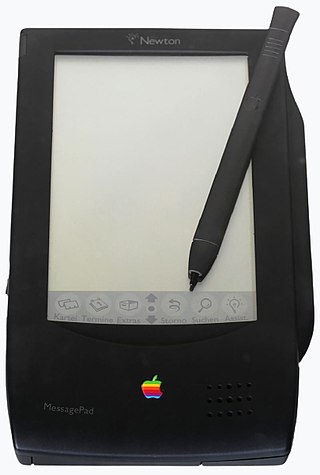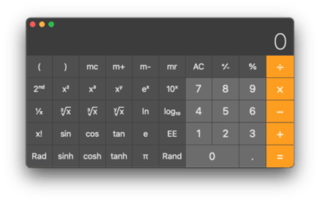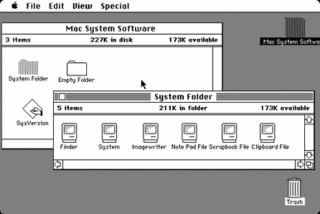
The MessagePad is a discontinued series of personal digital assistant devices developed by Apple Computer for the Newton platform in 1993. Some electronic engineering and the manufacture of Apple's MessagePad devices was undertaken in Japan by Sharp. The devices are based on the ARM 610 RISC processor and all featured handwriting recognition software and were developed and marketed by Apple. The devices run Newton OS.

A personal digital assistant (PDA), also known as a handheld PC, is a multi-purpose mobile device which functions as a personal information manager. PDAs have been mostly displaced by the widespread adoption of highly capable smartphones, in particular those based on iOS and Android, and thus saw a rapid decline in use after 2007.

Handwriting recognition (HWR), also known as handwritten text recognition (HTR), is the ability of a computer to receive and interpret intelligible handwritten input from sources such as paper documents, photographs, touch-screens and other devices. The image of the written text may be sensed "off line" from a piece of paper by optical scanning or intelligent word recognition. Alternatively, the movements of the pen tip may be sensed "on line", for example by a pen-based computer screen surface, a generally easier task as there are more clues available. A handwriting recognition system handles formatting, performs correct segmentation into characters, and finds the most possible words.

Graffiti is an essentially single-stroke shorthand handwriting recognition system used in PDAs based on the Palm OS. Graffiti was originally written by Palm, Inc. as the recognition system for GEOS-based devices such as HP's OmniGo 100 and 120 or the Magic Cap-line and was available as an alternate recognition system for the Apple Newton MessagePad, when NewtonOS 1.0 could not recognize handwriting very well. Graffiti also runs on the Windows Mobile platform, where it is called "Block Recognizer", and on the Symbian UIQ platform as the default recognizer and was available for Casio's Zoomer PDA.
The PenPoint OS was a product of GO Corporation and was one of the earliest operating systems written specifically for graphical tablets and personal digital assistants. It ran on AT&T Corporation's EO Personal Communicator as well as a number of Intel x86 powered tablet PCs including IBM's ThinkPad 700T series, NCR's 3125, 3130 and some of GRiD Systems' pen-based portables. It was never widely adopted.

System 7, codenamed "Big Bang", and renamed Mac OS 7 since version 7.6, is the main operating system for Macintosh computers from Apple Computer. It succeeded System 6 upon launch on May 13, 1991, and new features since then include virtual memory, personal file sharing, QuickTime, QuickDraw 3D, and an improved user interface.
PlainTalk is the collective name for several speech synthesis (MacinTalk) and speech recognition technologies developed by Apple Inc. In 1990, Apple invested a lot of work and money in speech recognition technology, hiring many researchers in the field. The result was "PlainTalk", released with the AV models in the Macintosh Quadra series from 1993. It was made a standard system component in System 7.1.2, and has since been shipped on all PowerPC and some 68k Macintoshes.

Apple Inc. uses a large variety of typefaces in its marketing, operating systems, and industrial design with each product cycle. These change throughout the years with Apple's change of style in their products. This is evident in the design and marketing of the company. The current logo is a white apple with a bite out of it, which was first utilized in 2013.
Inkwell, or simply Ink, is the name of the handwriting recognition technology developed by Apple Inc. and built into the Mac OS X operating system. Introduced in an update to Mac OS X v10.2 "Jaguar", Inkwell can translate English, French, and German writing. The technology made its debut as "Rosetta", an integral feature of Apple Newton OS, the operating system of the short-lived Apple Newton personal digital assistant. Inkwell's inclusion in Mac OS X led many to believe Apple would be using this technology in a new PDA or other portable tablet computer. None of the touchscreen iOS devices – iPhone/iPod/iPad – has offered Inkwell handwriting recognition. However in iPadOS 14 handwriting recognition has been introduced, as a feature called Scribble.

Calculator is a basic calculator application made by Apple Inc. and bundled with its macOS, iOS, and watchOS operating systems. It has three modes: basic, scientific, and programmer. The basic mode includes a number pad, buttons for adding, subtracting, multiplying, and dividing, as well as memory keys. Scientific mode supports exponents and trigonometric functions. The macOS version of Calculator also has a programmer mode that gives the user access to more options related to computer programming.

A tablet computer, commonly shortened to tablet, is a mobile device, typically with a mobile operating system and touchscreen display processing circuitry, and a rechargeable battery in a single, thin and flat package. Tablets, being computers, have similar capabilities, but lack some input/output (I/O) abilities that others have. Modern tablets largely resemble modern smartphones, the only differences being that tablets are relatively larger than smartphones, with screens 7 inches (18 cm) or larger, measured diagonally, and may not support access to a cellular network. Unlike laptops, tablets usually run mobile operating systems, alongside smartphones.
The term PenPad was used as a product name for a number of Pen computing products by different companies in the 1980s and 1990s. The earliest was the Penpad series of products by Pencept, such as the PenPad M200 handwriting terminal, and the PenPad M320 handwriting/gesture recognition tablet for MS-DOS and other personal computers.

The Advanced Technology Group (ATG) was a corporate research laboratory at Apple Computer from 1986 to 1997. ATG was an evolution of Apple's Education Research Group (ERG) and was started by Larry Tesler in October 1986 to study long-term research into future technologies that were beyond the time frame or organizational scope of any individual product group. Over the next decade, it was led by David Nagel, Richard LeFaivre, and Donald Norman. It was known as Apple Research Labs during Norman's tenure as VP of the organization. Steve Jobs closed the group when he returned to Apple in 1997.

Pen computing refers to any computer user-interface using a pen or stylus and tablet, over input devices such as a keyboard or a mouse.

The Newton is a series of personal digital assistants (PDAs) developed and marketed by Apple Computer, Inc. An early device in the PDA category, it was the first to feature handwriting recognition. Apple started developing the platform in 1987 and shipped the first devices in August 1993. Production officially ended on February 27, 1998. Newton devices ran on a proprietary operating system, Newton OS; examples include Apple's MessagePad series and the eMate 300, and other companies also released devices running on Newton OS. Most Newton devices were based on the ARM 610 RISC processor and all featured handwriting-based input.

The Macintosh "System 1" is the first version of Apple Macintosh operating system and the beginning of the classic Mac OS series. It was developed for the Motorola 68000 microprocessor. System 1 was released on January 24, 1984, along with the Macintosh 128K, the first in the Macintosh family of personal computers. It received one update, "System 1.1" on December 29, 1984, before being succeeded by System 2.
The history of tablet computers and the associated special operating software is an example of pen computing technology, and thus the development of tablets has deep historical roots. The first patent for a system that recognized handwritten characters by analyzing the handwriting motion was granted in 1914. The first publicly demonstrated system using a tablet and handwriting recognition instead of a keyboard for working with a modern digital computer dates to 1956.

Notes is a notetaking app developed by Apple Inc. It is provided on their iOS, iPadOS and macOS operating systems, the latter starting with OS X Mountain Lion. It functions as a service for making short text notes, which can be synchronized between devices using Apple's iCloud service. The application uses a similar interface on iOS and macOS, with a non-textured paper background for notes and light yellow icons, suggesting pencil or crayon. Until 2013, both applications used a strongly skeuomorphic interface, with a lined, textured paper design; the Mountain Lion version placed this inside a leather folder. This design was replaced in OS X Mavericks and iOS 7.

Freeform is a digital whiteboarding application developed by Apple for macOS, iOS, and iPadOS devices, first revealed during the 2022 Worldwide Developers Conference, and officially launched on December 13, 2022, alongside iOS 16.2, iPadOS 16.2, and macOS 13.1. It allows users to create infinitely scaling canvases called "boards", which can display a range of inputs including text notes, photos, documents, and web links. There are also a variety of pen and brush tools available on the iOS and iPadOS versions of the software, letting users add sketches or handwriting to their boards similar to the tools available in the Notes app, which are compatible with the Apple Pencil.















